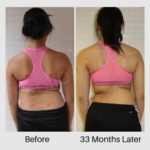- 12-year-old female
- Initial Cobb angles 53º/71º
- Risser 3
Scoliosis was first detected in this patient from western NY by a school nurse. Area doctors confirmed an official diagnosis of 53° and 71° scoliosis and recommended immediate scoliosis surgery. They also ordered an MRI to rule out any abnormalities (because of the patient’s apparent rapid onset of severe scoliosis).
The MRI, taken that same month, revealed that Cobb angles (53°/71° in a standing x-ray) measured 40°/48° in the supine (lying on back) position. When lying down, there is less gravity weighing on the spine which can affect Cobb angle measurement. In certain cases, doctors may order supine X-rays before surgery (in addition to the standing scoliosis x-rays) to assess spinal flexibility–but this is not routine.
Wanting to try non-surgical scoliosis treatment, her parents decided to make the trip to Boston for a brace and a week of Schroth immersion therapy. While the outlook for this degree of curvature is not as promising as moderate or mild scoliosis, SJ demonstrated an incredible work ethic and, over time, managed to achieve an exceptional result. Her parents also brought her to Boston on a fairly regular basis for close follow-up and brace adjustments since her spine was changing over the course of her treatment.
The last standing x-ray we have of her, shown on the right, was taken just before she began weaning from her brace. That x-ray shows Cobb angles of 42° and 46°. Her result is quite an achievement–especially considering she began as a very severe curve and accomplished this via our Schroth program protocols and bracing only!



